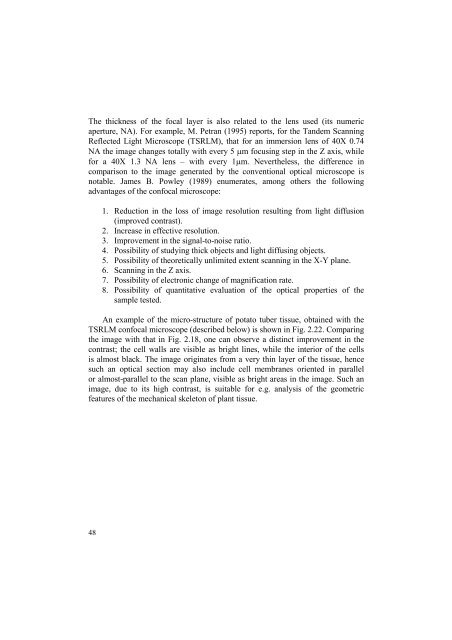MICRO-STRUCTURE ANALYSIS OF PLANT TISSUES - Lublin
MICRO-STRUCTURE ANALYSIS OF PLANT TISSUES - Lublin
MICRO-STRUCTURE ANALYSIS OF PLANT TISSUES - Lublin
Create successful ePaper yourself
Turn your PDF publications into a flip-book with our unique Google optimized e-Paper software.
The thickness of the focal layer is also related to the lens used (its numeric<br />
aperture, NA). For example, M. Petran (1995) reports, for the Tandem Scanning<br />
Reflected Light Microscope (TSRLM), that for an immersion lens of 40X 0.74<br />
NA the image changes totally with every 5 µm focusing step in the Z axis, while<br />
for a 40X 1.3 NA lens – with every 1µm. Nevertheless, the difference in<br />
comparison to the image generated by the conventional optical microscope is<br />
notable. James B. Powley (1989) enumerates, among others the following<br />
advantages of the confocal microscope:<br />
1. Reduction in the loss of image resolution resulting from light diffusion<br />
(improved contrast).<br />
2. Increase in effective resolution.<br />
3. Improvement in the signal-to-noise ratio.<br />
4. Possibility of studying thick objects and light diffusing objects.<br />
5. Possibility of theoretically unlimited extent scanning in the X-Y plane.<br />
6. Scanning in the Z axis.<br />
7. Possibility of electronic change of magnification rate.<br />
8. Possibility of quantitative evaluation of the optical properties of the<br />
sample tested.<br />
An example of the micro-structure of potato tuber tissue, obtained with the<br />
TSRLM confocal microscope (described below) is shown in Fig. 2.22. Comparing<br />
the image with that in Fig. 2.18, one can observe a distinct improvement in the<br />
contrast; the cell walls are visible as bright lines, while the interior of the cells<br />
is almost black. The image originates from a very thin layer of the tissue, hence<br />
such an optical section may also include cell membranes oriented in parallel<br />
or almost-parallel to the scan plane, visible as bright areas in the image. Such an<br />
image, due to its high contrast, is suitable for e.g. analysis of the geometric<br />
features of the mechanical skeleton of plant tissue.<br />
48

















